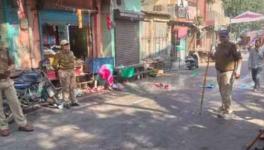Locating Agency – Interrogating ‘Adhikaar’ of Van Gujjar Women at Rajaji National Park, Uttarakhand
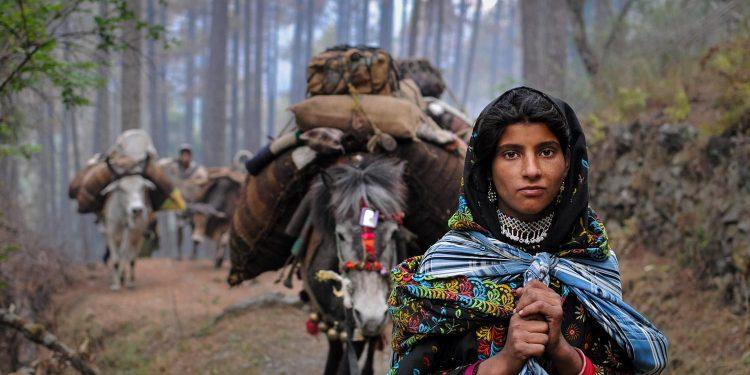
Courtesy: The Better India
In light of the Van Gujjar community securing individual and community forest rights, PRANAV MENON and TUISHA SIRCAR enunciate on the expression of agency by women of this community while asserting their forest rights in the face of resistance from both the State and stratified gender roles within their community.
————-
“Agar koi bolte ki bachche hai yaha aur bhaise hai toh danda chala dete the.” [if we told them (forest rangers) that there are children and buffaloes here, they would nevertheless beat us with sticks.]
This statement by Fatima, 32, a Van Gujjar woman from Kunaon Chaur, Gohri range was made in the backdrop of a violent episode by the state forest department that sought for her family’s eviction. The hamlet, with around 70 deras, traditionally the winter homestead of Van Gujjars, is located within the core zone of the Rajaji National Park. The bid to evict and resettle Van Gujjars from the landscape has been a perennial project of the department, which was stalled in November 2017, by residents of this hamlet, especially the women. In the backdrop of this incident, this piece seeks to explore how the rights based approaches under myriad forest legislations have failed to encompass the agency for women to access forest lands and negotiate their existence within forests.
The struggle for meaningful coexistence within forests and assertion of customary rights for access to grazing lands, lopping and migration to summer homesteads has become increasingly cumbersome for nomadic pastoralists today. The forest department has fostered a logic of fortress conservation within Protected Areas on its quest to make such spaces ‘inviolate’ for wildlife from human interference. Despite the enactment of the Scheduled Tribes and Other Traditional Forest Dwellers (Recognition of Forest Rights) Act, 2006 (hereinafter, FRA), that sought to assuage the historical injustice and deprivation of rights in the past, the Van Gujjars still negotiate with the threats such as encroachment notices and eviction orders issued by the forest department from time to time.
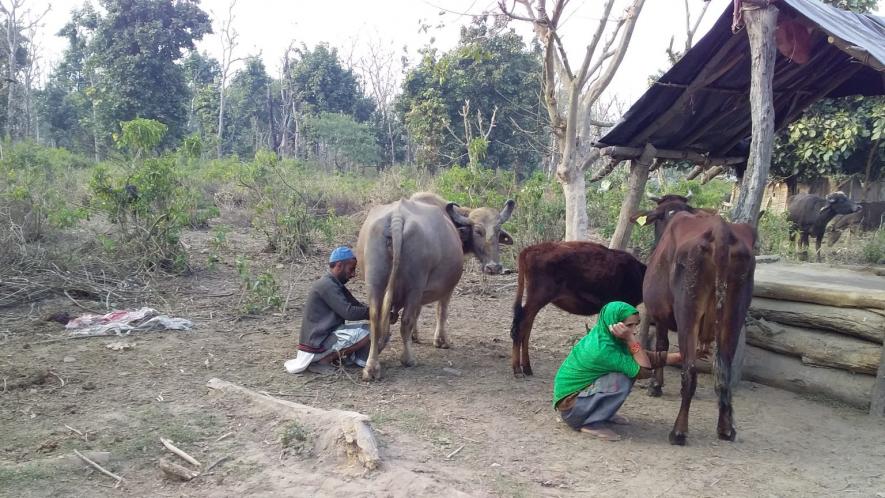
While sincere efforts are being made to file land claims by the Van Gujjars, most notably through the Van Gujjar Tribal Yuva Sanghatan (hereinafter, Sanghatan), it is imperative to analyze whether this struggle for enabling tenure rights moves beyond ownership and property claims to ensure occupancy and greater access to grazing lands at both homesteads, coupled with claims on migration routes and rights of use within forests.
We wish to interrogate such vivid conceptions of land tenure amongst Van Gujjar women, on whether their ability to freely access forest lands for traditional household uses and grazing their livestock is inhibited by the forest department’s policies of conservation. We are also keen to highlight that while the FRA has sought to enhance greater participation of women forest dwellers through representation in Forest Rights Committees, the Van Gujjar women continue facing barriers, both within the community as well as the masculine State machinery, for effective realization of rights. It is crucial to enquire how these women display agency while negotiating with a ‘legalism’ enforced by the forest department, which seems alien to them and whether any steps can be taken through the Sanghatan to cultivate a legal pluralism amongst the Van Gujjars, that recognizes greater assertion of these women whilst deciding on questions of land, resettlement, forest rights or development of the community. Such an inquiry would go a long way to determine the agency of Van Gujjar women as equitable stakeholders in negotiating forestry policies.

Also read: Odisha: Rural Women Celebrate Siali Uchsav for Forest and Livelihood Protection
The missing ‘participation’ of Van Gujjar women under the Forest Rights Act, 2006
The role of forest dwellers, especially women, to facilitate equitable and positive conservation outcomes is well recognised. Economist Bina Agarwal has previously identified that inclusion of women in forest management roles has not only enhanced greater participation towards protection of forest lands but also promotes claims for ownership as well as increased flow of information regarding biodiversity and ecosystem regulation. It also allows women to express their existing traditional knowledge and conservation practices freely without inhibition and holds potential for developing sustainable land management plans.
The FRA was meant to include Van Gujjar women in conservation activities by enhancing their security within forests through legitimate claim-making of traditional customary land uses and protect them from threats of eviction. Despite Section 4(5) of the Act stipulating that no eviction can be conducted till recognition of rights under the Act is complete, the forest department is not keen to recognise the FRA as applicable to Van Gujjars, by continuing to consider their presence as encroachment.
The FRA also mandated one-third representation of women in the Forest Rights Committees (hereinafter FRCs) and made women key participants within the gram sabhas that decide upon the finality of claims as well as conservation and development issues. However, as is the case with several nomadic pastoralists, the representation of women within these communities is tokenistic without any emphasis on whether they can access forests freely and without any inhibition. Mariyam, a member of the FRC in Kunaon Chaur, was selected precisely for her awareness regarding forests, yet the institution has not met often for her to address the concerns women face within forests.
Furthermore, while the Sanghatan has initiated the process of constituting an FRC and filing of land claims, there has been no sincere effort yet to recognise community tenure of the forests as a common pool resource. The preference of individual forest rights over traditional and multiple user tenure reform, as anthropologist and environmental scientist Purabi Bose, too, has identified in the context of implementation of FRA, propagates gender asymmetries within the community as customary use of land is relegated towards a notion of private property. Such conceptualisation of tenure, which negates how access to forest lands as an ‘adhikaar’ [right] matters more than recognition of individual rights, a space wherein women can freely carry out their labour without apprehension, highlights how the FRA and its rights based discourse has been co-opted by the language of property or commodity.
While men and women within the community regularly perform similar activities within the forests, cutting and transporting leaf fodder for the animals or collecting firewood, it is mostly the men who are seen as controlling access to forest resources, and holding permits and other documents to negotiate with the forest department. This reflects the penetration of the masculine structure of the State within the community that legitimizes negotiation with men through informal or formal means at the cost of isolating women to the private sphere. The ‘painchi‘, a traditional caste panchayat amongst Van Gujjars, is a meeting amongst the ‘lambardars’ (the eldermost male member of a dera) for resolving disputes pertaining to marriages, financial issues or livestock, with punishments such as compromise, fines or social boycott. But this institution fails to engender the role of women as equals for negotiating these issues and denies them space to voice their opinions, even if it concerns them or their family members.
While women do engage in discussions at ‘beithhaks‘, held amongst Van Gujjar men to discuss social and political affairs, most men generally consider women lacking knowledge of State affairs, the law and policies. Sukha Bibi, a mother of five children and matriarch of a dera, having internalised the lack of education amongst these women, iterates ”hume toh jyaada kanoon ki jankari nahi hai, par humein jangal mein haq mile woh behtar hai” [we do not have much knowledge about the law but would prefer to claim rights to stay within forests]. Unfortunately, none of the court orders till date which related to halting eviction or allowing migration and access to forests explicitly enunciate upon the rights of Van Gujjar women or highlight their concerns. Thus, these women face a dual marginalization both from the institutional State machinery as well as from within the community, which denies them any legitimate exercise of agency within forests.
Also read: Jammu and Kashmir has made a travesty of Forest Rights Act
Exploring the gendered nature of conservationist policies on Van Gujjar women
American political theorist Wendy Brown has argued that the State structure which is working through the nodes and networks of bureaucratic technology is inherently masculine in nature. The gendered body of women is regulated through certain protection codes which are key technologies that regulate privileged women as well as intensifies the vulnerabilities and degradation of those who are already marginalised, based on certain socially constructed identities and occupations. Thus, despite the prevalence of rights under the Indian Constitution or several legislations, such as the FRA, the question of agency of women is often determined by enquiring about their access to forest lands, their ability to take decisions on the forest management or community development, or financial autonomy within home.
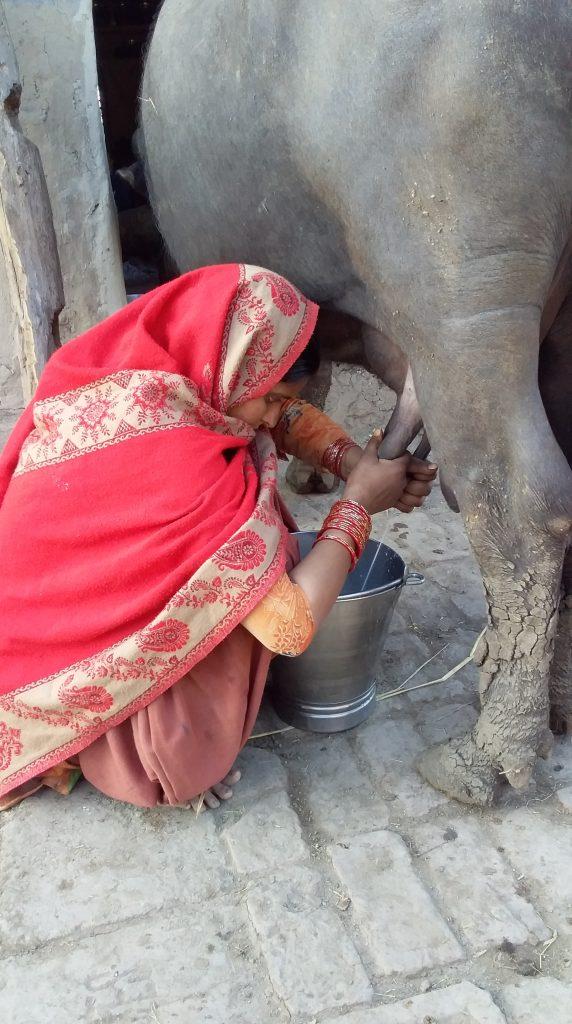
The inability of the forest department to view spaces of coexistence amongst nomadic pastoralists and wildlife, despite greater ecological benefits from the same such as the prevention of forest fire, checks on invasive species and monocultures, and the regular management of watering holes within forests prevalent from the continual presence of the Van Gujjars, indicates a masculinist bias to exert control over natural resources by the State. The National Commission for Denotified, Nomadic and Semi-Nomadic Tribes, in its reports in 2008 and 2017, acknowledged the adverse impact of wildlife protection laws and creation of national parks, which ousted such nomadic tribes from their livelihood and ancestral homes, and that there continues to be a criminality attached to such communities, which extends to their women and children.
The advent of afforestation laws like the Compensatory Afforestation Fund Act, 2016 that identify green cover from the lens of trees and categorize grasslands as ‘wastelands’ to be made productive reflect the masculinist nature of conservationist policies. Coupled with the enclosure of forests, such policies do not associate traditional use of graziers, especially women, by discounting their labour within forests and isolating them from utilization of produce. Previously, the forest which was identified as a space for diversity and security for women in their traditional use is now increasingly being replaced by fenced plantations of select species of trees that inhibit grazing, lopping and allied activities.
Despite the Forest Rights Act stipulating that no eviction can be conducted till recognition of rights under the Act is complete, the forest department is not keen to recognise the Act as applicable to Van Gujjars, by continuing to consider their presence as encroachment.
These activities are no longer seen as productive to the political economy of modern scientific forestry. Roshan Bibi exclaims “jangalaat hum gujjaro ke kaam ko paryavaran ke hit mein nahi dekhta lekin gujjar ke koi kaam jangal ko khatam karne ke liye nahi par uske parvarish ke liye hai” [the Forest department views Van Gujjars and their subsistence based activities within the forest as fostering degradation of the ecosystem without associating to the regenerative benefits of grazing and lopping and their encouragement for diversified species within their compartments].
These women face a dual marginalization both from the institutional State machinery as well as from within the community, which denies them any legitimate exercise of agency within forests.
The demarcation of the hamlet within the core zone of the Rajaji National Park has resulted in several inhibitions regarding security and surveillance for women within the forests. On the other hand, the denial of access to forest lands for grazing and utilization of minor forest produce disproportionately impacts the workload of Van Gujjar women, who have to spend greater time in collection of produce and household chores. Zulekha, another resident of Kunaon Chaur, believes the everyday labour of collecting firewood and grass has doubled since her traditional route has been restricted by a wildlife check post, forcing her to take a longer path to procure them from the forest.
The women, however, used to be at the forefront of the migration and were often made to negotiate access with the forest department to their summer homesteads. But increasing conflicts on the migration routes of Van Gujjars has forced many of them to abandon transhumance altogether or leave behind their families in the winter homestead at Rajaji Park itself. The increasing pressure on the graze lands within the Protected Area throughout the year fosters a continuing land conflict between the forest department and the community. This conflict is exhibited through myriad encroachment notices issued and eviction drives conducted by the forest department wherein violence is borne by the women as well. Neither the Wildlife Protection Act, 1972 nor the Uttarakhand Forest Act, 2001, prescribe any safeguards for a gender sensitive approach, such as, for instance, the presence of female staff during such eviction threats.
Locating the agency of Van Gujjar women within resistance to State
An episode from 2017 is etched in the memory of these women when none of due process safeguards were practised by the forest department. Fatima vividly remembers that the ‘jangalaat’ forcefully entered Kunaon Chaur and started vandalising their ‘chappar’ to force eviction from forest land.
The increasing pressure on the graze lands within the Protected Area throughout the year fosters a continuing land conflict between the forest department and the community. This conflict is exhibited through myriad encroachment notices issued and eviction drives conducted by the forest department wherein violence is borne by the women as well.
What occurred thereafter brings forth an exercise of agency which displayed these womens’ role as caretakers of the dera and the land as well as children and cattle. Even though the ‘jangalaat’ successfully broke down some of the ‘chappars’, the women did not fall back, and continued resisting with full fervour till the former left. The jangalaat here represents the masculinist State structure where force and violence is extended towards those whose rights are violated as forest dwellers. According to Fatima, the forest is their home and no matter what the jangalaat does, the Van Gujjars will not leave their home. She also recalled how an older and well respected woman in the community was also assaulted because she directly challenged the jangalaat.
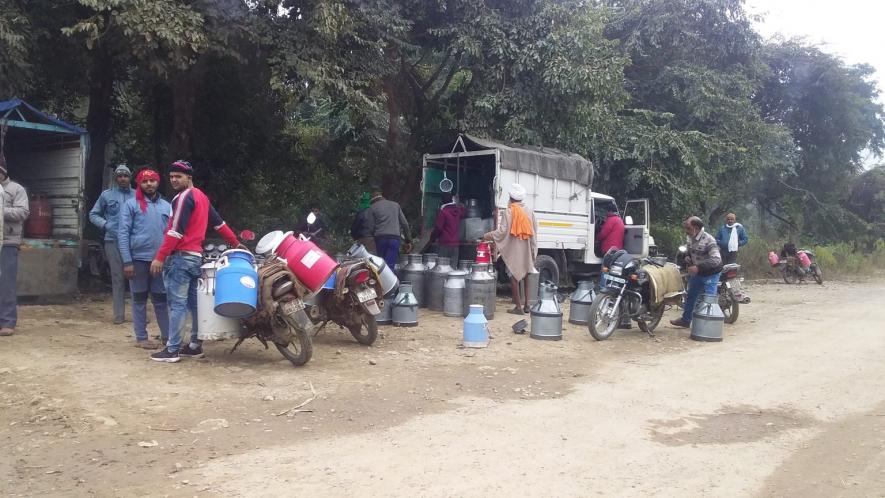
This incident brings to the fore a very important aspect related to how Van Gujjar women asserted their agency and broke the divide between public and private spheres. Traditionally, Van Gujjar women remain within a structure of subordination within the community, where men take on the responsibilities related to livelihood and decision making. Some women engage in activities such as fetching water, collecting firewood from the forest, grazing or even lopping. But largely, women cook food, wash clothes, and take care of the young ones in their houses. However, talking to more women across different ages led to the realisation that their agential existence falls within a vast array of motivations, desires and goals. The performance of their reality cannot be understood completely from the lens of domination and resistance, but also must include their everyday adaptations and display of resilience.
Traditionally, Van Gujjar women remain within a structure of subordination within the community, where men take on the responsibilities related to livelihood and decision making. Some women engage in activities such as fetching water, collecting firewood from the forest, grazing or even lopping. But largely, women cook food, wash clothes, and take care of the young ones in their houses.
Academic Dr Rubina Nusrat argues that Van Gujjar women have developed myriad coping mechanisms in the face of sedentarization. Her work demonstrates there is greater participation of women in decision making processes, especially regarding the cattle and the milk products, which the men sell in the marketplace. They also perform their role as livestock managers determining the fodder required. This is because most Van Gujjar women get cattle as ‘mehr’, which allows them complete ownership of it and therefore control over the livestock.
On the other hand, sedentarization has also led to the increase in institutionalisation of the public-private divide which also came out in Fatima’s narrative. Jaitun, another Van Gujjar woman, believed “humein yahi zameen mile woh behtar hai taaki jangal aur praali ki suvidha mile” [We should get land here itself because it ensures easy access to the forests and grasslands]. Thus, the voices of these women exhibit an aspiration for collective agency within their everyday lives. However, while collective participation of women is prominent in their day-to-day reality and continues to be key for the conservation of the forest, they still lack decisional autonomy on such issues under the FRA.
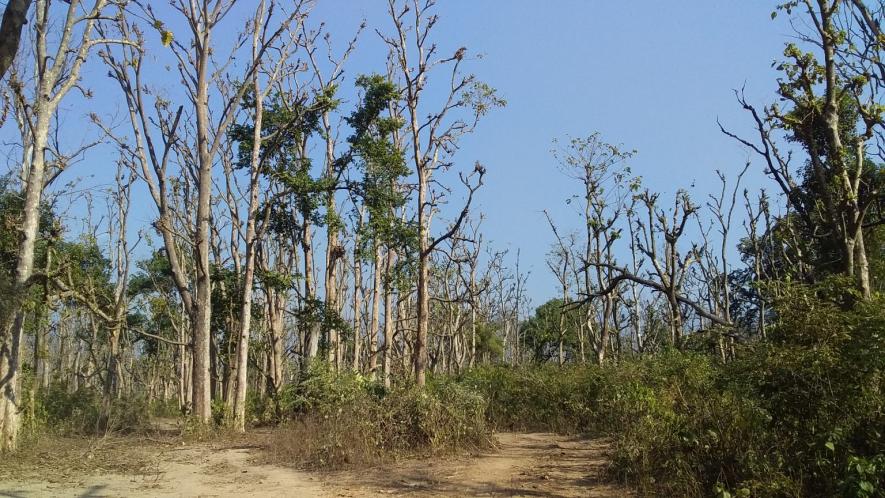
The Sanghatan acknowledges these structural barriers which women face within forests, and is keen to reorganise the community on equal lines by seeking to promote educational initiatives, conservation drives, legal literacy, healthcare and reproductive health workshops, revitalise documentation of traditional knowledge of women and engage them in self-help groups for fostering their cultural art and handicraft items such as jewellery, dari (bedspread), caps, pankha (hand-fans), and so on. The Sanghatan also remains a credible forum to engage in resistance against the dominance of colonial forestry policies wherein women can be better accommodated.
Nonetheless, the empowerment and recognition for Van Gujjar women remains an ongoing negotiation amongst the community as well as the State. It is hoped a pluralistic model towards land can be envisioned that recognises unrestricted access and diversified uses to calibrate the agency for women, who desire continued residence within forests.
(All featured photos are from Kunao Chaur, and are courtesy of the authors.)
(Pranav Menon is a Research Scholar at the Centre for Law and Governance, Jawaharlal Nehru University. Tuisha Sircar is an Independent Researcher. The authors are grateful to Mohamad Meer Hamja, President, Van Gujjar Tribal Yuva Sanghatan for facilitating the authors’ empirical research at Kunao Chaur, Gohri range, Pauri Garhwal district, Uttarakhand. The views expressed are personal.)
Get the latest reports & analysis with people's perspective on Protests, movements & deep analytical videos, discussions of the current affairs in your Telegram app. Subscribe to NewsClick's Telegram channel & get Real-Time updates on stories, as they get published on our website.














